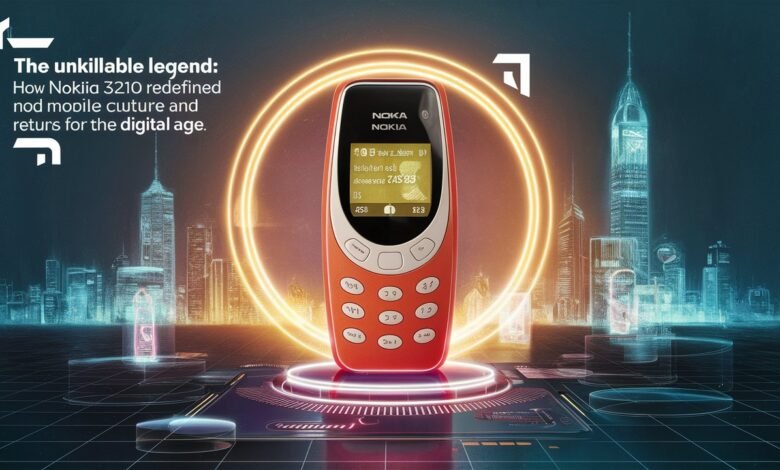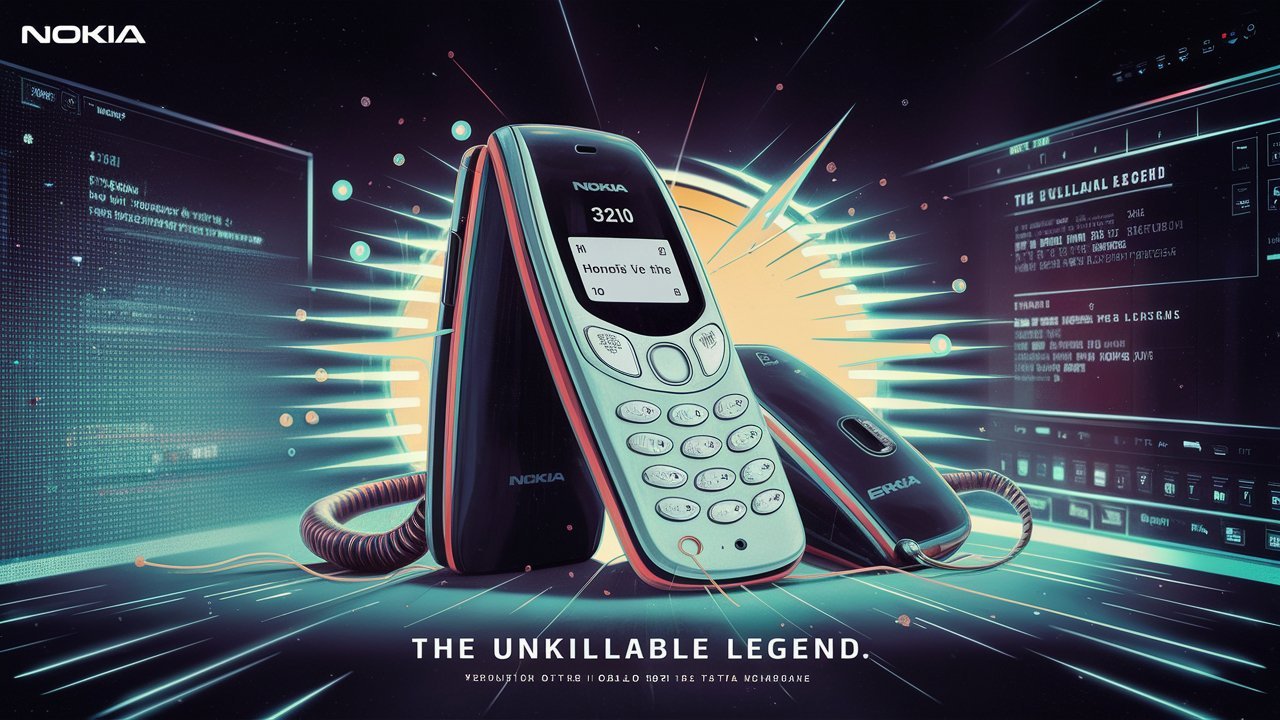The Unkillable Legend: How Nokia 3210 Redefined Mobile Culture and Returns for the Digital Age

Introduction: The Brick That Built Modern Mobile Life
Emerging in 1999 amidst Y2K fever, the Nokia 3210 wasn’t just another cellphone—it was a cultural detonator. Designed by Alastair Curtis under Frank Nuovo’s leadership at Nokia’s Los Angeles studio, this unassuming “brick” targeted an overlooked demographic: teenagers and young adults 14. Prior mobile devices were business tools—bulky, antenna-protruding status symbols. Nokia flipped the script, selling 160 million units by prioritizing durability, customization, and playful functionality 19. A quarter-century later, HMD Global’s 2024 revival taps into digital fatigue, rebranding simplicity as a radical act against smartphone overload 46. This article explores how a plastic rectangle became a global icon and why its return challenges our tech-saturated reality.
1. Design Revolution: Shattering Conventions with Curves and Covers
The Nokia 3210’s physical design was a masterclass in user-centric innovation. At 123.8 x 50.5 x 22.5 mm and 151g, it discarded the external antenna—a first for mass-market phones—inspired by luxury models like the Nokia 8810 110. This wasn’t merely aesthetic; it enhanced pocketability and durability. Polycarbonate shells survived concrete drops, while interchangeable “Xpress-on” covers (a carryover from the 5110) transformed devices into personal canvases 49. Users customized with DIY hacks—colored cellophane under keys, bespoke paint jobs—turning utilitarian objects into extensions of identity 4. The green-backlit monochrome LCD (84×48 pixels) housed a Texas Instruments CPU, balancing simplicity with just enough visual feedback for SMS or games 110. This design ethos—robust, adaptable, human—contrasted sharply with the era’s fragile, elitist gadgets.
2. The Texting Revolution: T9, Composer, and the Birth of Mobile Linguistics
Before smartphones, the 3210 engineered a silent communication upheaval. Its integration of T9 predictive text transformed tedious typing: by mapping letters across numeric keys, SMS became viable for casual conversation 410. Nokia’s Composer software amplified this, letting users code monophonic ringtones via note sequences—a precursor to app stores. Shared via SMS, these tunes spawned early digital communities 110. Limited picture messaging (e.g., preloaded “Happy Birthday” images) hinted at future multimedia ecosystems 10. Crucially, these features democratized mobile use. Students coordinated meetups, families shared updates, and texting eclipsed calling as the default for a generation—all powered by a removable 1250 mAh NiMH battery lasting days 910.
3. Cultural Artifact: Snake, Status, and the Shared Experience
The 3210 transcended utility through ritual. Snake—a deceptively simple pixel game—became a communal obsession. Public transport filled with players chasing high scores, its addictive loop echoing Tetris’ psychological grip 49. Unlike today’s isolated scrolling, the 3210 fostered shared moments: swapping ringtones, comparing covers, or passing phones during queues 9. Cinema cemented its icon status, featuring in films as a symbol of youthful connectivity 9. For millions, it was their first phone—a rite of passage. As AndroGuru notes, it represented “a simpler, more connected era” where devices facilitated presence rather than distraction 9. This cultural footprint explains why original units still trade online and why HMD’s 2024 launch sparked global sell-outs 12.
4. 2024 Revival: Nostalgia as Digital Antidote
HMD’s 2024 reinterpretation bridges eras. Outwardly, it echoes the original’s silhouette but slims to 122 x 52 x 13.1 mm and 87g, swapping monochrome for a 2.4-inch QVGA color screen 712. Internally, it’s a tech hybrid: 4G LTE replaces 2G, Bluetooth 5.0 enables wireless headsets, and USB-C charges the removable 1450 mAh battery (rated for 9.8 talk hours) 311. A 2MP camera with LED flash nods to modern expectations, while the Unisoc T107 chipset runs the S30+ OS 1112. Yet this isn’t a smartphone in disguise. HMD positions it as a “detox” tool, stripping back notifications and endless apps. Brenden Folitarik, HMD Australia’s GM, confirms targeting “digital fatigue,” noting dumb phone sales rise yearly as users crave “micro detoxes” 46. Even Snake returns—alongside paid games like Crossy Road—balancing nostalgia with controlled diversion.
Table: Evolution of Key Features
| Feature | 1999 Original | 2024 Revival |
| Network | GSM 900/1800 | 4G LTE + 2G fallback |
| Battery | 1250 mAh NiMH (5 days standby) | 1450 mAh Li-ion (days of use) |
| Display | 1.5″ monochrome (84x48px) | 2.4″ QVGA color (240x320px) |
| Connectivity | None | USB-C, Bluetooth 5.0 |
| Storage | SIM-only (250 contacts) | 128MB + microSD (up to 32GB) |
| Extras | Ringtones composer | MP3 player, FM radio, camera |
5. Critical Reception: Between Nostalgia and Practicality
Reviews highlight paradoxical expectations. Tech sites praise the reboot’s “newstalgia” (CNET’s “dumb-phone renaissance”) but question inclusions like a rudimentary Facebook app, clashing with the detox premise 712. Nokiamob’s testing noted “fair call quality” and “impressive build,” yet criticized clunky menus and sunlight-readable displays 7. Journalists like The Guardian’s Zoe Wood documented love-hate experiences: “Liberating and a huge pain” summed up transitioning from smartphones 12. At ~€79, some argue the Nokia 235 4G offers better value, though the 3210’s design cachet justifies premiums for many 7. In China, stocks sold out in two days, proving nostalgia’s commercial power 12. Ultimately, its success lies not in specs, but in symbolizing mindful tech use—a counterculture manifesto in plastic form.

6. Legacy and Lessons: Why the 3210 Still Matters
The 3210’s influence permeates modern mobile design. Its internal antenna became industry standard, while customizable skins foreshadowed iPhone cases and Android themes 19. More profoundly, it proved mobiles could be emotional, not just functional. As ManofMany observes, it shifted focus from “important™ things” to laughter, gossip, and shared games—laying groundwork for social media’s connective tissue 4. HMD’s revival underscores enduring principles: durability counters throwaway culture; simplicity combats attention economies; playfulness humanizes tech 69. In a 2024 Deloitte survey, 78% of respondents actively limit screen time—revealing appetite for the 3210’s philosophy 4. It remains a benchmark because, unlike transient “flagships,” it solved human needs: belonging, expression, resilience.
Table: Cultural Impact Elements
| Aspect | 1999-2005 Impact | 2024 Relevance |
| Customization | Xpress-on covers, DIY mods | Color variants (Y2K Gold, Scuba Blue) |
| Gaming | Snake as social phenomenon | Preloaded Snake + paid modern minigames |
| Communication | SMS/texting popularization | “Joy of missing out” (calls/texts only) |
| Durability | “Indestructible” reputation | Shock-resistant casing, removable battery |
| Battery Life | Days-long usage | Multi-day endurance vs. smartphones |
Conclusion: The Eternal Brick
The Nokia 3210’s journey—from 1999 disruptor to 2024 detox artifact—reveals cyclical tech truths. Innovation isn’t just processing power; it’s designing for joy and resilience. HMD’s reboot succeeds not by replicating the past, but by recontextualizing its ethos for overwhelmed digital natives 612. As we face AI saturation and planned obsolescence, the 3210 whispers: technology should serve humans, not enslave them. Its return is a referendum on what we’ve lost—and a toolkit for reclaiming presence.
Frequently Asked Questions
Q: What key differences separate the 1999 and 2024 Nokia 3210 models?
A: The original featured monochrome graphics, no camera, and 2G connectivity, focusing on calls/SMS. The 2024 model adds 4G LTE, a 2MP camera, Bluetooth 5.0, color display, USB-C charging, and expandable storage—while retaining the iconic form and Snake 3712.
Q: Can the new 3210 replace a smartphone permanently?
A: Unlikely for most. It lacks apps like WhatsApp, maps, or email. However, as a secondary device for vacations, focus periods, or reducing screen time, it excels. HMD promotes “micro detoxes,” not full substitution 47.
Q: How durable is the 2024 version compared to the original?
A: While retaining a sturdy polycarbonate build, it’s slimmer and lighter (87g vs. 151g). The removable battery survives drops better than sealed units, but lacks the original’s legendary “tank” reputation 711.
Q: Does it support music streaming or social media?
A: No streaming services exist. An FM radio and MP3 player (via microSD) handle audio. A basic Facebook app is included but impractical for heavy use due to T9 typing constraints 57.
Q: Why did Nokia’s 3210 become culturally iconic?
A: It democratized mobile tech via affordability ($200 launch price), introduced texting/gaming to youth, and offered customization in an era of uniform devices. Its durability created trust, while Snake fostered shared experiences 1910.



